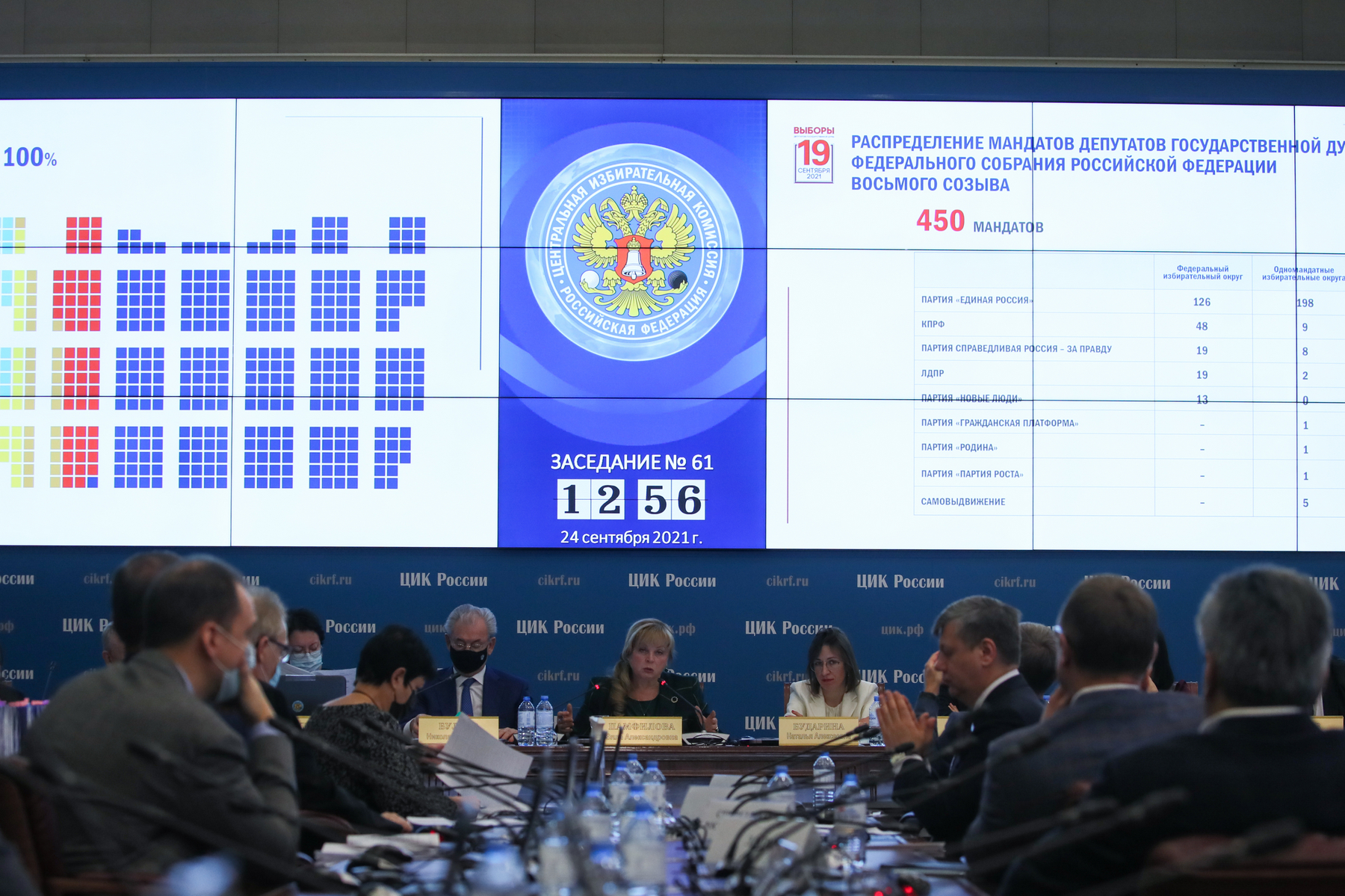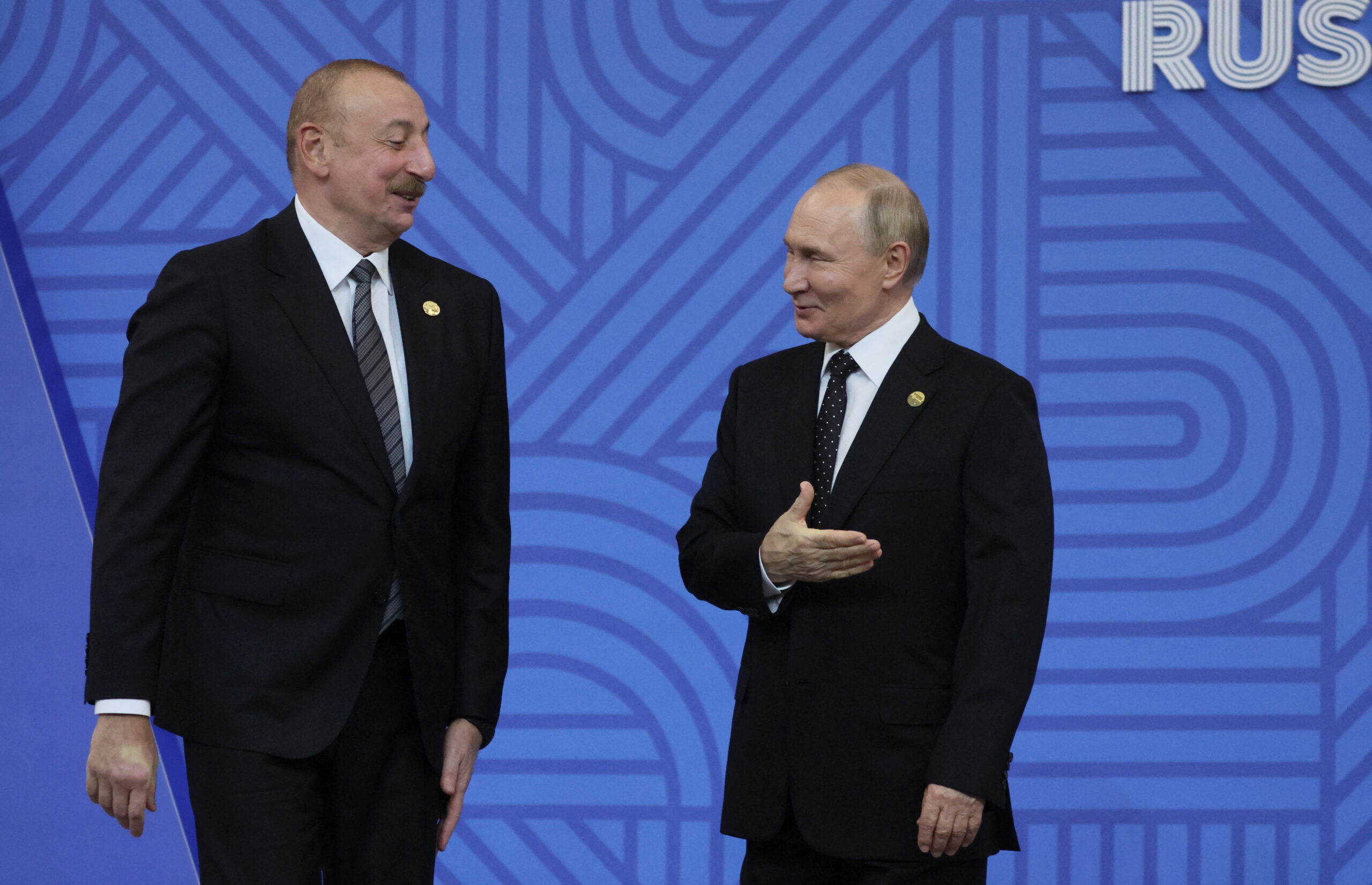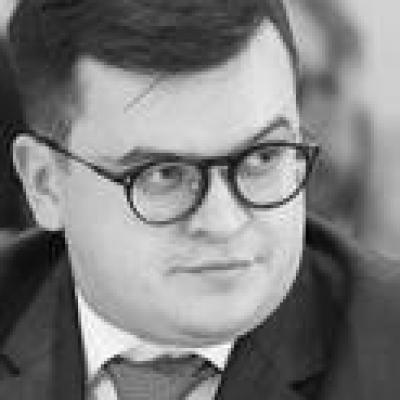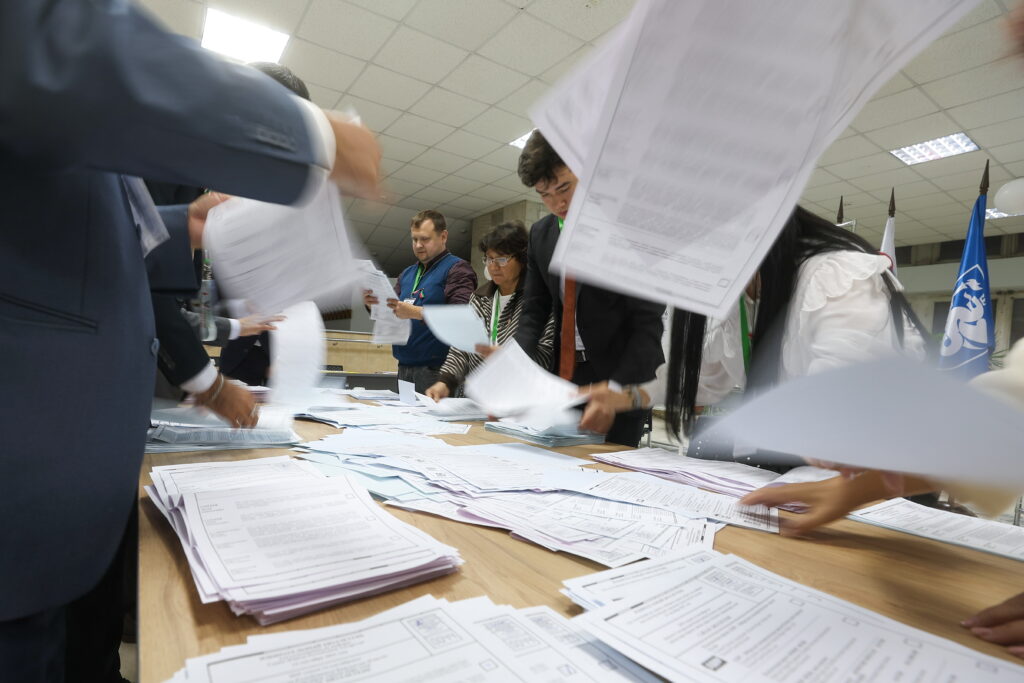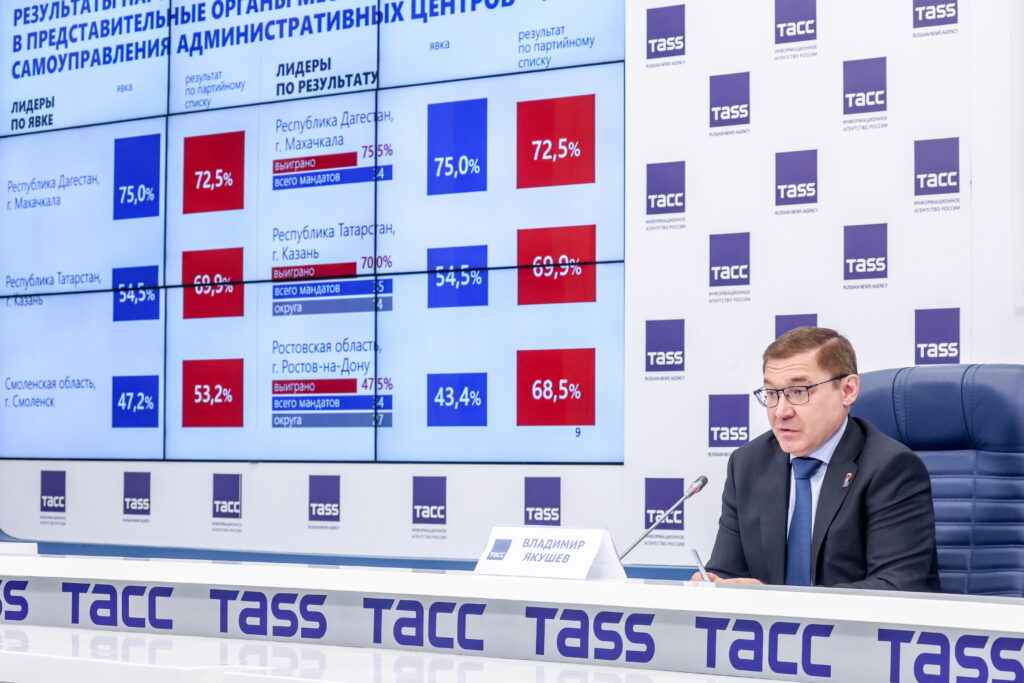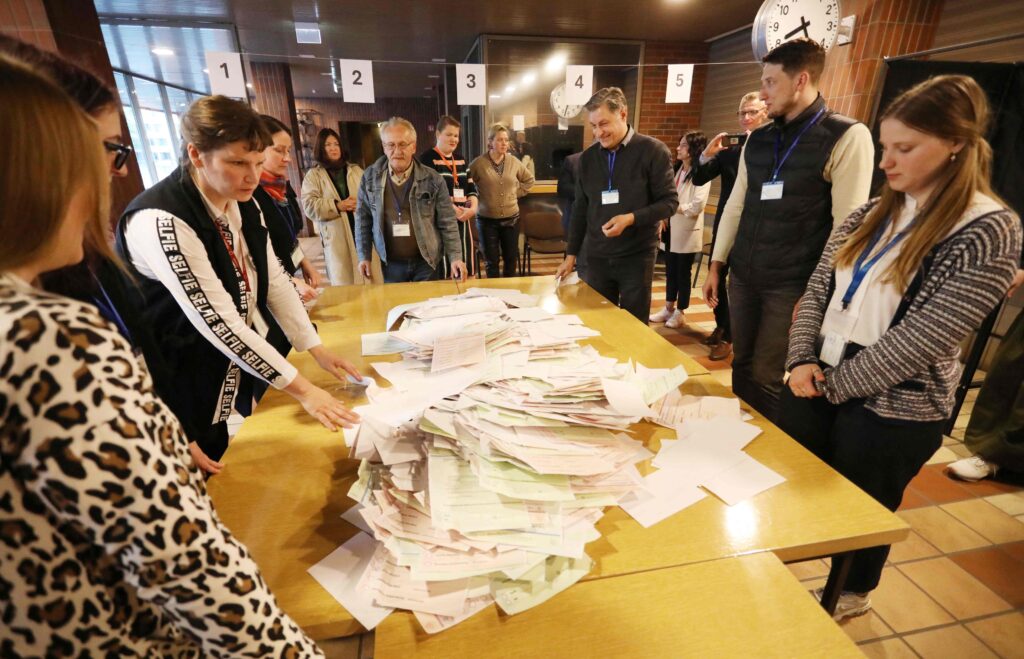On 17–19 September 2021, Russia held elections to its State Duma alongside some 4.5 thousand other elections at the regional and local level. According to official data, United Russia (UR) got 49.82% of the vote in the federal elections, followed by the Communist Party of the Russian Federation (CPRF) with 18.93%, the Liberal-Democratic Party of Russia with 7.55%, A Just Russia – For Truth with 7.46%, and New People gaining 5.32%. The turnout stood at 51.72%. By winning in an overwhelming majority of single-member constituencies, United Russia gained a constitutional majority in the Duma again.
Actual results
However, one can hardly trust these data. Observers reported widespread falsifications and their work was harshly opposed at some polling stations. The data obtained from civic activists across the country by Golos, the movement for the protection of voters’ rights (recognised by the Russian authorities as a “foreign agent”), indicate that the “party of power” most likely gained 25–40% of the vote. This is also confirmed in comparisons of neighbouring precincts or territories (with and without observers) in a wide range of regions. Moreover, whether we are talking about Bashkortostan, Tatarstan or the nearby Moscow region, the results observed at polling stations which had reliable monitoring rarely go beyond this range. In all such polling stations, the CPRF gained, on average, about 30%, which means that the two parties are very close to each other.
Various specialists in electoral statistics have obtained similar data. Sergey Shpilkin and Alexei Kupriyanov have reported that United Russia’s actual electoral results fell mostly within the same range, and the voter turnout was below 40%. According to statistical experts, all the other votes came from “ballot box stuffing” or, at the very least, were cast under coercion. Our observation experience and our data from the final reports indicate that in the overwhelming majority of cases we are talking about non-existent votes rather than the outcome of administrative mobilisation. All the electoral peculiarities of Russia’s territories also fall within the same rather wide range of 25–40%. This difference runs not so much between the national republics and the majority of Russian regions, but between urban and rural areas, as is the case with all other modernised countries. The voting patterns in rural areas in Dagestan are about the same as in villages near Ryazan.
Some other data also show that the results obtained by the two parties should be very close to each other. This is evidenced, for instance, by the number of reactions under social media posts mentioning the two parties: throughout the election campaign, these indicators were running hand in hand, with just a small gap (with all the other parties falling far behind).
In reality, United Russia scored approximately the same as in 2011, but with a much lower turnout. In other words, its support, measured by the number of votes, dropped significantly, even in comparison with those indicators from the past. The CPRF has actually come out as the second strongest party, almost equal to UR, which is a highly interesting consequence of this election. Now, we need to watch closely how the CPRF will react to this development.
How did the authorities manage to report such high figures while the real support was much lower? We have already written about the evolution of the campaign, which, of course, was neither free nor fair, but still did not enable the “party of power” to reach its target scores. The situation had to be “rectified” during the voting days using “traditional” Russian methods.
Mass voter coercion
The scale of coercion was aptly demonstrated by VCIOM, which, on 8 September, published the results of its pre-election poll among industrial workers (according to Rosstat, the industrial sector employs approx. 19 million people), commissioned by the Expert Institute for Social Research, an institution close to the Kremlin. According to the poll, 48% of workers said that they had encountered some kind of unlawful influences from their employers which went beyond the nature of the employment relationship. When we consider the size of the industrial sector, this translates to approx. 9 million voters, i.e. about 16% of the official turnout in this election. However, similar influences were reported also outside industrial enterprises: coercion was faced by people employed in almost any sphere, from public sector to commercial enterprises.
Multiple-day voting created additional opportunities for coercion. This was particularly evident in the early hours of Friday morning, when huge queues lined up at some precinct electoral commissions across the country. They were made of people who had previously de-registered from their polling stations at home addresses and signed up at polling stations geographically assigned to their workplace address as they had to prove their presence at the elections to the superiors.
Online voting was not conducive to the free expression of will, either. When paper ballots are used, people can be pressured to show up at the polling station but then they can still vote in line with their preferences. In contrast, people may have reasonable suspicions that electronic voting cannot preserve the secrecy of their choices.
New forms of voting cannot be monitored
Online voting and three-day voting cannot easily be subjected to public scrutiny. In fact, the former does not lend itself to monitoring at all (this time, more than 2 million people voted online, i.e. approx. 4–5% of the official turnout).
The monitoring of multiple-day voting also causes major problems. Firstly, it calls for an enormous number of observers. Russia has almost 100,000 polling stations, and each of them needs at least two or three people to monitor everything that happens there. But even if those can be found, there are still night-time hours when the ballots and other documentation of the election commissions remain unattended. They can only stay intact if there is strict adherence to procedures for packing the documents and sealing the premises. However, due to the increased complexity of the already incomprehensible voting procedures, the rules were not followed even by those precinct commissions that acted without bad intentions: people were simply exhausted and irritated and refused to follow procedures which made no sense to them. As a result, it turned out to be impossible in most cases to ensure that the votes remain intact at night.
Already on the first night, evidence began to flow in, indicating illegal intrusions into polling stations: someone would stay at electoral commission premises at night, and in the morning it was found that seals were torn off, safes were opened, and safe packages had been repacked.
At-home voting
Voting outside the voting premises, or “at home,” is a traditional problem in Russian elections. While the number of observers to monitor the events in the voting premises is insufficient, at-home voting usually remains uncontrollable altogether. This is further facilitated when election commissions violate the procedures when conducting such voting.
At one stage, the Central Electoral Commission (CEC) of the Russian Federation even began to fight against this technology consciously. However, the problem intensified again this year: while 3.5 million people voted “at home” in 2016, this figure rose to 8.1 million in 2021.
“Traditional” falsifications
The usual ballot box stuffing, proxy voting or multiple voting by the same person, all of which have traditionally been part of the Russian electoral landscape, did not disappear this time, either. In a number of regions, observers and party representatives reported that falsifiers were caught or some citizens found that someone had already voted in their name.
The reactions from the system of electoral commissions is quite telling. The CEC of Russia already significantly restricted video surveillance this year and, after the first reported cases of ballot box stuffing, the CEC began to create problems for parties who wanted to record streaming from screens. In some regions, election commissions of the constituent entities of the Russian Federation instructed lower-level commissions to report citizens who complained that someone had already voted in their name. This kind of reaction can only be seen as hysteria.
Obstruction of observers’ work
The possibility to verify the accuracy of the vote count is an integral part of active suffrage (i.e. the right to cast a vote). For this very reason, the possibility of observation is a necessary precondition for elections to be recognised as fair and free. Unfortunately, violations of the rights of observers, members of commissions, media reporters and even the candidates themselves at the polling stations came back in full swing this year.
For at least five years, Golos has not encountered so many reports of obstruction against observers and commission members, let alone instances of violence and threats. Between midnight and 8:00 p.m. (GMT+3) on 19 September, Golos received 329 reports of violations of the rights of observers, commission members and media representatives. Over the three days of voting, Golos received 882 such reports from 54 regions.
Apart from the election commissions’ refusal to observe the procedures, forceful counteraction was noted in some regions, sometimes turning into criminal acts: organised groups of people in track suits were “on duty” in and around the voting premises, and they engaged in forceful counteraction or simply psychologically pressure or threats against the observers. In Kazan, a group of unidentified people seized a polling station and did not let anyone in until the commission announced the election results. Observers’ and candidates’ cars were blocked and their wheels were punctured. Moreover, the police did not counteract such behaviour and, worse still, would cover it up. This year, the situation in Tatarstan, Krasnodar region, Greater Moscow and St. Petersburg was particularly noteworthy. Moreover, observers and commission members were simply removed from polling stations without a court decision. This time, such problems were encountered even at polling stations outside Russia.
Conclusion
This year’s elections surpassed the two previous federal election campaigns (2016 and 2018) by far as regards the number of reported cases of potential irregularities received by Golos. In terms of numbers, the results obtained by the “party of power” and the atmosphere surrounding the elections, these voting days turned out to resemble the 2012 elections. The Russian electoral system seems to have started a new circle, but after the defeat of Alexei Navalny’s support structures, this time the CPRF turned out to be the centre of the opposition. The Communist Party is facing a difficult time ahead. On the one hand, it must not lose support, and needs to increase it by adapting to the new role of the country’s second strongest party. On the other hand, it must survive in these conditions without giving the Kremlin a reason to smash the CPRF as the new non‑systemic opposition. This task is further complicated by the fact that the Kremlin has also taken notice of the election results and is most likely dissatisfied with them.
